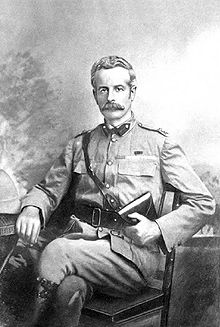Douglas Cochrane, 12th Earl of Dundonald
The Earl of Dundonald | |
|---|---|
 The Earl of Dundonald in 1904 | |
| Born | 29 October 1852 Banff, Scotland |
| Died | 12 April 1935 (aged 82) Wimbledon, England |
| Buried | Achnaba Churchyard, Ardchattan |
| Allegiance | |
| Service | |
| Years of service | 1870–? |
| Rank | Lieutenant General |
| Commands | General Officer Commanding the Militia of Canada 2nd Regiment of Life Guards |
| Battles / wars | Mahdist War Second Boer War First World War |
| Awards | Knight Commander of the Order of the Bath Knight Commander of the Royal Victorian Order Mentioned in Despatches (7) |
Lieutenant General Douglas Mackinnon Baillie Hamilton Cochrane, 12th Earl of Dundonald, KCB, KCVO (29 October 1852 – 12 April 1935), styled Lord Cochrane between 1860 and 1885, was a Scottish representative peer and a British Army general.
Early life
Cochrane was the second but eldest surviving son of Thomas Cochrane, 11th Earl of Dundonald, by Louisa Harriet Mackinnon, daughter of William Alexander Mackinnon. Thomas Cochrane, 1st Baron Cochrane of Cults, was his younger brother.[1] He was educated at Eton College.[2]
Military career
Cochrane was commissioned into the Life Guards in July 1870,[3] and was promoted to lieutenant the following year and captain in 1878.[4] He served in the Nile Expedition,[3] the Desert March and the Relief of Khartoum in 1885.[5] He was appointed Commanding Officer of 2nd Life Guards in 1895.[3]
He served in the Second Boer War and in November 1899 he was appointed Commander of the Mounted Brigade, part of the South Natal Field Force.[3] He took part in the Relief of Ladysmith in February 1900,[3] although his South African troops, unimpressed by his leadership, referred to him as “Dundoodle”.[6]
In April 1902, it was announced that Lord Dundonald would be appointed General Officer Commanding the Militia of Canada,[4] the senior military officer in Canada. He left Liverpool on 15 July,[7] and arrived in Quebec and Ottawa later the same month to take up his position.[8] Lady Dundonald joined him in Ottawa, where they stayed in Crichton-lodge. He served in Canada for two years.[3]
He later served in the First World War as Chairman of the Admiralty Committee on Smoke Screens in 1915.[3]
Lord Dundonald was appointed a Commander of the Royal Victorian Order (CVO) in December 1901,[9] and in June 1907 knighted as a Knight Commander (KCVO) of the order.
Dundonald Park, in Centretown, Ottawa, is named after him.
Family
Lord Dundonald married Winifred Bamford-Hesketh, daughter of Robert Bamford-Hesketh, in 1878. They had two sons and three daughters. The family lived for many years at Gwrych Castle in North Wales, the seat of the Bamford-Hesketh family. The Countess of Dundonald did not accompany her husband to Canada. She died in January 1924. Lord Dundonald died at his home in Wimbledon in April 1935, aged 82, and was succeeded in the earldom by his eldest son, Thomas.[1] He is buried in Achnaba Churchyard, Ardchattan near Benderloch, Lorne, Argyll & Bute.
See also
References
- ^ a b [thepeerage.com Lt.-Gen. Douglas Mackinnon Baillie Hamilton Cochrane, 12th Earl of Dundonald]
- ^ Dundee Courier. 13 April 1935. p. 7.
{{cite news}}: Missing or empty|title=(help) - ^ a b c d e f g "King's College London Liddell Hart Centre for Military Archives entry". Retrieved 3 May 2006.
- ^ a b "The Command of the Canadian Militia". The Times. No. 36737. London. 9 April 1902. p. 6. template uses deprecated parameter(s) (help)
- ^ The Peerage.com
- ^ Farrar-Hockley 1974, p43
- ^ "Lord Dundonald´s departure for Canada". The Times. No. 36821. London. 16 July 1902. p. 9. template uses deprecated parameter(s) (help)
- ^ "Latest Intelligence - Lord Dundonald at Ottawa". The Times. No. 36831. London. 28 July 1902. p. 5. template uses deprecated parameter(s) (help)
- ^ "No. 27390". The London Gazette. 24 December 1901. p. 9061.
Books Used for Citations
- Farrar-Hockley, General Sir Anthony (1975). Goughie. London: Granada. ISBN -0246640596.
- Use dmy dates from November 2012
- British Army generals
- Canadian generals
- Earls of Dundonald
- Scottish representative peers
- 1852 births
- 1935 deaths
- British Life Guards officers
- British Army personnel of the Mahdist War
- British Army personnel of the Second Boer War
- British Army personnel of World War I
- Knights Commander of the Order of the Bath
- Knights Commander of the Order of St Michael and St George
- People educated at Eton College
